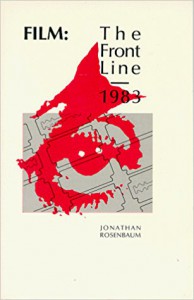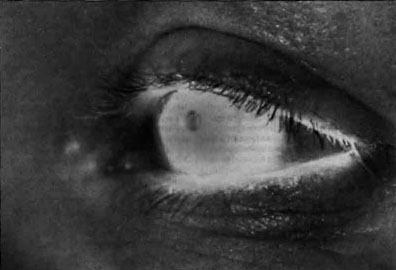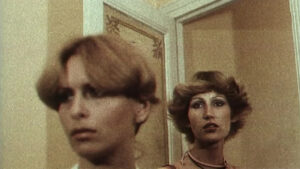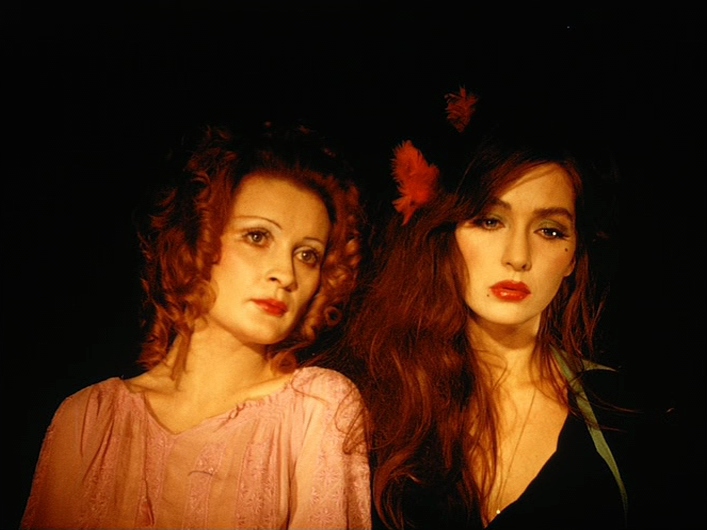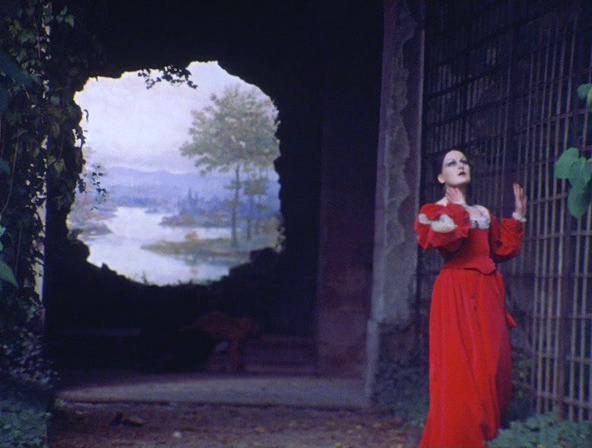My book Film: The Front Line 1983 (Denver: Arden Press), intended by its editor-publisher to launch an annual series, regrettably lasted for only one other volume, by David Ehrenstein, after two other commissioned authors failed to submit completed manuscripts. Miraculously, however, this book remained in print for roughly 35 years, and now that it’s finally reached the end of that run (although some copies can still be found online), I’ve decided to reproduce more of its contents on this site, along with links and (when available) illustrations. I’m beginning with the book’s end, an Appendix subtitled “22 More Filmmakers,” which I’m posting here in three installments, along with links and (when available) illustrations. — J.R.
MAURIZIO NICHETTI is a name I happen to know strictly by chance. My last trip to Europe (and only trip to Italy) consisted of three days at the Venice Film Festival in 1979, where I was invited to participate in a conference devoted to Cinema in the Eighties. And as I noted in an account of that conference in the December 1979 American Film, one film that I happened to see during those three days, Maurizio Nichetti’s Ratataplan — a first feature with an onomatopoeic title based on the sound of a drum cadence — may have actually suggested more about the subject of the conference than any of the lectures I heard. Since then, Ratataplan, a popular favorite of sorts at Venice, has gone on to become a monster hit in Italy, and I’m told has already occasioned one or two follow-up comedy features from Nichetti. But despite some initial interest in opening the film in the U.S. — to the point where I even recall seeing a coming-soon poster for it in a Manhattan arthouse cinema in the early 1980s — American audiences have been deemed not ready for it. In addition to writing and directing, Nichetti plays the central character, a shy, unassuming café waiter named Colombo. (Nichetti played a substantial part as an orchestra conductor in the live-action portions of the animated feature Allegro Non Troppo, and some American spectators may recall his wiry frame and mousy mustache from that film.) In an early sequence, a participant at an international conference in a skyscraper has a heart attack, and Colombo — who operates a refreshment stand on a hilltop on the other side of the vast metropolis — is summoned by phone to bring this poor, suffering fellow a glass of mineral water. Colombo goes hurtling down the hill with his tray, and his convoluted journey across Rome — during which his glass of water gets sprayed by exhaust fumes, covered by a policeman’s cap, and speckled with white paint, before a bee unceremoniously drowns in it with a Tatiesque fizzle — becomes an epic, absurdist poem about contemporary urban life, concocted out of nearly equal bits of Clair, Tati, and Lewis crossed with some of the literary madness of a Carroll, a Gogol, and a Sterne. Later, this poem turns nightmarish when Colombo puts together a robot duplicate of himself inside his dingy tenement flat, using various odds and ends from the city dump, including a video camera that fits neatly inside the headpiece. Guiding his suave, remote-control better self out the front door with a fixed steering wheel like a puppeteer, and picking up its precise viewpoint in a TV monitor, Colombo promptly gets his robot to score with the girl downstairs and take her out disco dancing. Is Ratataplan avant-garde? Apparently it isn’t in Europe, but fashion dictates that it assume that dubious position over here, where you can’t see it because somebody assumes it will be bad for your health. Could it be the mixture of fantasy and whimsy with satire and comedy that scares off potential distributors and programmers? I could always be wrong about this, but I have a terrible suspicion that the adults who previewed Ratataplan neglected to bring their kids along; if they had brought them, they might have discovered how funny it is.
The only film I’ve seen by ANDREW NOREN is the feature-length Charmed Particles (1977), Part IV of his ongoing The Adventures of the Exquisite Corpse, which I’ve seen twice. Limited thematically, more or less, to the male-possessions vantage point, the film nonetheless has so much to “say” about light and texture — something that affects all our daily visual experience, a subject that spreads out over our lives as blandly, as completely, and, most of the time, as unmemorably as a picnic tablecloth over a patch of ground — that I can’t really ignore it. So black and white it can make you forget that color films exist, and so sensually rich it may make you want to go on a movie diet afterwards, this exquisite chronicling of Noren’s self-confessed activity as a “light thief” and “shadow bandit,” mainly within the limited yet limitless confines of a small city apartment, is fortunately silent, too. It creates a visual music so concentrated that I’m sure any musical accompaniment would be redundant or, even worse, reductive in effect. Often evoking the luminous textures of certain European films in the Twenties (like the pulsating light patterns of F. W. Murnau’s Faust), as well as the pantheism and “poetic structuralism” of Louis Hock — with smoke, hair, leafy textures and fabrics treated as delicately as brushstrokes, then mixed together in a sort of light blender that suggests Josef von Sternberg’s teasing manner of dissolving his own glittering bric-à-brac — Charmed Particles can lead one off in many possible directions, most of them internal. Mottled shadows flicker across an eye, a horizontal wipe reveals clothes swaying on a line (like a glissando running up a keyboard), silvery light speckles a floor or atomizes on quivering water or turns a woman’s hair into the Milky Way, wind blows snow crystals at night, fragments of fabric drift past an open window (in a peekaboo pattern remaining a basic rhythmic component throughout, a perpetual give-and-take of now you see it/now you don’t), parts of human and feline bodies and diverse objects conspire in activities (walking, dishwashing, reading the paper, looking at a TV or a movie still, climbing stairs). If this is formalism, the least that can be said for Noren is that he makes the most of it.
(copyrighted by the estate of Andrew Noren)
More than an adaptation of dance to film, the 40-minute, Canadian Shades of Red represents a profound collaboration between filmmaker DAVID RIMMER and choreographer PAULA ROSS; the only precedent that comes to mind is Yvonne Rainer’s assumption of both roles in Lives of Performers, where the overall effect of the private/public dichotomy is more fictionalized. The structure is carefully worked out through the interactions between the two artists, which start with Ross reciting a parable about a scorpion and a frog (also used by Orson Welles in Mr. Arkadin) followed by a performance of her dancers. As off-the-cuff autobiographical remarks later become juxtaposed with her rehearsal of a piece to be done with (as opposed to for) the camera, the brew becomes still headier. By the exhilarating end, a mutual choreography of dancers, camera, and lights achieves a happy union of intentions. The images thus created — funny slapstick writhings, a man moving a woman’s body around like the human clock hands in Metropolis, cross-currents of pedestrian traffic — are keyed to arrangements of color, text, costume, movement, and light that are deftly cross-referenced.
RAUL RUIZ “has known three kinds of marginalization,” according to Ian Christie — introducing the second half of Afterimage No. 10 (Autumn 1981), devoted to “Myths of Total Cinema” (the first half focuses on Jean Epstein in the Twenties) — “all of them contributing to the present paradox of his considerable fame and influence, yet near-total inaccessibility.” As a pioneer of Chilean cinema in the late Sixties, a European exile since the military coup of September 1973, and a filmmaker who has worked almost exclusively on television commissions since 1975, Ruiz is triply invisible, one might say. His most important film by reputation is the 1978 L’Hypothèse du tableau volé (The Hypothesis of the Stolen Painting), celebrated in Cahiers du Cinéma. His most important recent film by legend is The Territory (1981) — a project that was inadvertently cut short by the last-minute decision to make Wim Wenders’s The State of Things on the same location in Portugal with many of the same actors, cannibalizing in effect a film about cannibals so that another sort of film about survival could be made.* The only Ruiz film I’ve seen, in fact, is an extraordinary short, Le Colloque de chiens (Dog’s Dialogue), shown in an excellent English version prepared by Michael Graham at the New York Film Festival in 1980, and, so far as I can tell, almost totally ignored in the press. To quote Ruiz himself on this wonderful film (from a Cahiers interview quoted in Afterimage):
What interests me are all the possibilities of relations, misunderstandings, between what is seen and what is said. For Le Colloque I took a story from Detective, cut out various phrases and made a new story in which the same phrases were repeated in relation to different events. It runs through several times but it is always the same phrase that recurs. This is the whole trick. The title does not have much connection with Cervantes. I inserted shots of dog barking, originally with subtitles: ‘Love,’ Hate,’ ‘Violence.’ I interlinked three kinds of film, one which is a kind of photo-novel (the main narrative is entirely in stills), another which has talking dogs, and a third which shows real places referred to in the photo-novel, the streets and monuments framed in a banal manner.
* Ironically, Ruiz wasn’t the only filmmaker cut short. Jon Jost, who was shooting a documentary on Ruiz making Le Territoire for the British Film Institute as a sort of follow-up to his Godard 1980, also wound up with an unfinished film. Ruiz’s film, however, unlike Jost’s, was completed in its “unfinished” form.

WERNER SCHROETER remains a key missing link in the contemporary German avant-garde as far as this country is concerned, apart from scattered screenings of Eika Katappa (1969) and The Death of Marie Malibran (1972), probably still his best films, and in spite of the writing of Gary Indiana in Artforum and an article by Timothy Corrigan in Discourse (No. 3). It is surely the narrative bias of the New York Film Festival that promoted a likably mediocre director from the same campy school, Daniel Schmid, while totally ignoring the remarkable non-narrative meditations of Schroeter, whose level of intensity seems equal at moments to the great silent directors. Unfortunately, for a fan like myself who was primed on this non-narrative work, the more recent forays of Schroeter into more respectable areas — The Kingdom of Naples (1978), Dress Rehearsal (1980), and Wolfsburg or Palermo (1981)—have all been disappointments. The latter, which seems more interesting from an experimental standpoint after the Felliniesque post-neorealism of the first and the personal documentary of the second (about a theater festival in Nancy, France) — a film that starts off in a neorealist mode and Italian location, and winds up in Germany and expressionism — fritters away most of its interest through an overextended narration that flattens out all of Schroeter’s most interesting effects. The problem is, to judge from the eight or nine of his features that I’ve seen over the years, his essential gifts are not narrative ones; yet it is narrative art, alas, that the world apparently requires of him.
If you don’t already know WAYNE WANG‘s first hit, Chan Is Missing (1980) — an independent black-and-white feature costing only $20,000 which deftly combines the detective story, the structural film, and an investigation into what it means to be Chinese-American in the present economic crisis — you should. Wang currently has two new features in the works for 1983, and I hope that the next volume in this series will have something to say about them.

